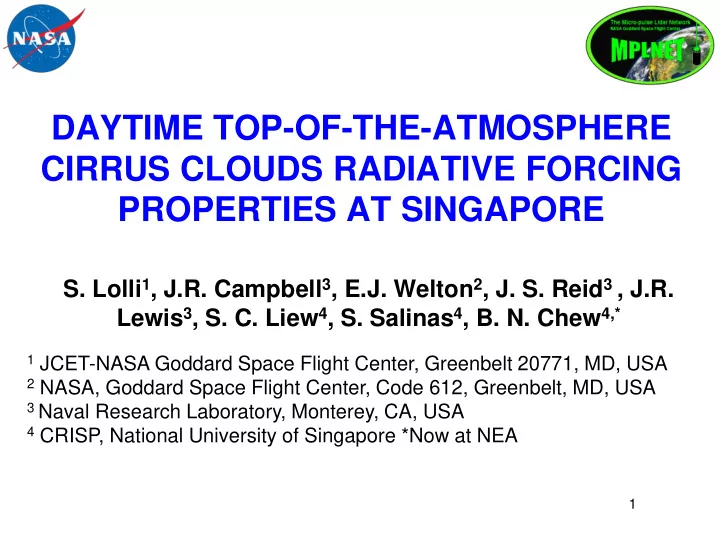

DAYTIME TOP-OF-THE-ATMOSPHERE CIRRUS CLOUDS RADIATIVE FORCING PROPERTIES AT SINGAPORE S. Lolli 1 , J.R. Campbell 3 , E.J. Welton 2 , J. S. Reid 3 , J.R. Lewis 3 , S. C. Liew 4 , S. Salinas 4 , B. N. Chew 4,* 1 JCET-NASA Goddard Space Flight Center, Greenbelt 20771, MD, USA 2 NASA, Goddard Space Flight Center, Code 612, Greenbelt, MD, USA 3 Naval Research Laboratory, Monterey, CA, USA 4 CRISP, National University of Singapore *Now at NEA 1
Cirrus cloud Facts • High level clouds (>12 Km Mid-Lat) consisting purely of ice crystals • Ice Super Saturated Regions (ISSR) are potentially cirrus formation regions • Homogenous freezing is probably the dominant freezing mechanism in low temperature / high altitude regimes (< 235 K) [Koop et al., 2004]. • Cirrus clouds coverage about 20%-30% of the earth surface (up to 70% in the tropics) 2
Cirrus Clouds still main source of uncertainty in climate model sensitivity • Modulators of earth radiation budget • Quantitative information is needed by observation, especially on optically thin sub-visible clouds (COD<0.03). • Cirrus Clouds net radiative forcing – Solar Albedo Effect( C ) – Infrared greenhouse effect( W ) – Which effect is outweighing ? 3
The Micro-Pulse Lidar Network: MPLNET Principal Investigator: Judd Welton, NASA GSFC Code 612 Network Manager: Sebastian Stewart, SSAI GSFC Code 612 Data Processing: Phillip Haftings, SSAI GSFC Code 612 Larry Belcher, SSAI GSFC Code 612 Science Team: James Campbell, Naval Research Lab Jasper Lewis, UMBC GSFC Code 612 Simone Lolli, UMBC GSFC Code 612 Administrative Support: Erin Lee, SSAI GSFC Code 612 CALIPSO Validation Activities: Judd Welton, James Campbell AERONET & Synergy Tool Partnership: Brent Holben, NASA GSFC Code 614.4 Dave Giles, NASA GSFC Code 614.4 NASA SMARTLABS Field Deployments: MPLNET information and results shown here are the Si-Chee Tsay, NASA GSFC Code 613 result of efforts by all of our network partners! Site Operations & Science Investigations …. many network partners around the world MPLNET is funded by the NASA Radiation Sciences Program and the Earth Observing System
MPLNET Overview Micro Pulse Lidar South Pole MPLNET Site: (GSFC Patent) 1999-current MPLNET Sites: 2000 - current Currently: 16 Active Sites MPLNET: 8.8Trillion Laser Shots, 59 Mminutes of data and counting… • A federated network of micro pulse lidar sites around the world, coordinated and lead from Goddard Space Flight Center • Co-location with related networks, including NASA AERONET • Local, regional, and global scale contributions to atmospheric research • Satellite validation • Aerosol climate and air quality model validation • Impact of aerosol & cloud heights on direct and indirect climate effects • Support for wide variety of field campaigns Example of MPLNET Level 1 Data: Atmospheric Structure What ’ s New? • Penang new site August 2014 Tropopause • More sites in Africa and in South America Cirrus • Ongoing interactions with both Aerocom and ICAP communities (climate and operational air quality modeling) Altitude (km) Investigators, Partners, & Collaborators: Transported Aerosol • Principal Investigator: Judd Welton/612 (Asian Dust, Pollution) • Brent Holben/618 Boundary Layer • Si -Chee Tsay /613 • James Campbell/NRL (local aerosol) • Sebastian Stewart/SSAI/612 • Larry Belcher/SSAI/612 • Simone Lolli/JCET- UMBC/612 • Jasper Lewis/JCET/612 Time UTC • Phillip Haftings /SSAI/612 • All Network Partners Worldwide http://mplnet.gsfc.nasa.gov
The New V3 Website http://mplnet.gsfc.nasa.gov 6
The New V3 Website Data 7
The new V3 Cloud Algorithm J. Lewis et al., 2015 Singapore, 01 April 2012 C A • A multi-temporal averaging scheme is used to improve performance in weak signal-to-noise. NRB B • Data flags will indicate the temporal resolution used Altitude (km) as well as the number of 1-minute profiles included in the average. Temporal Resolution Bitwise • The algorithm is applied to 2012 NRB data at GSFC. Flag • Algorithm output: 17011 detected single layer cirrus cloud extinction profiles. Time (UTC)
Parameterization for FLG Radiative Transfer Model Cloud Extinction Profiles are transformed into IWC and Dge profiles through Heymsfield parameterization From GEOS-5 • Power Law depending on temperature Dge(z)=a*exp(b*T) a, b depending on T From Lidar • Ice Water Content : IWC(z)=α(z)*0.303* Dge(z) • Cloud Net Radiative Forcing CRF net =CRF sw -CRF lw with CRF sw,lw =F cl sw,lw -F clr sw,lw 9
Cirrus Clouds SE Asia Frequency CALIPSO Data 2006-2015 • SEA Absolute cirrus cloud frequencies over water • Depolarization channel, - 37C threshold (Campbell et al., 2015) • Singapore close to 80% 10
MPLNET DATA, Singapore 2010-2011 11
MPLNET NET RF vs. COD 12
MPLNET NET RF vs. SZA 13
MPLNET NET RF vs. CTT 14
SEASONAL TRENDS Difficult to characterize any trend • NDJ stands out for exhibiting exclusively net negative forcing • MJJ is the only over-water period the estimates are all positive • Compelling that minimum over water in 2011 (-4.51 W/m2, NDJ) is in direct contrast with max over land (4.01 W/m2, FMA) 15
CONCLUSIONS • TOA CRF is estimated to be 2.8-3.3 W/m2 (2010) and 3-3.3 W/m2 (2011) over land, • TOA CRF is estimated -0.094 - 0.541 W/m2 (2010) and -0.598 - 0.433 W/m2 • Seasonal estimates are consistent, with NDJ showing lower values with respect other months • Novelty: cirrus being the only genus that can readily induce both positive and/or negative daytime TOA CRF , depending on their physical characteristics • Global oceans are subject to negative daytime TOA CRF, presuming the forcing sign changes meridionally at lower latitudes than believed likely over the lands. 16
What’s next? How daytime cloud forcing may vary with latitude and season? 17
Thank you MPLNET STAFF • PI: Judd Welton/612 • James Campbell/NRL • Jasper Lewis/JCET-UMBC/612 • Simone Lolli/JCET-UMBC/612 • Larry Belcher/SSAI/612 • Sebastian Stewart/SSAI/612 18
Recommend
More recommend